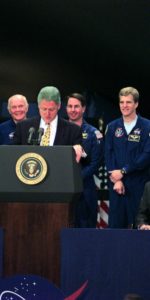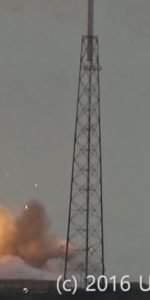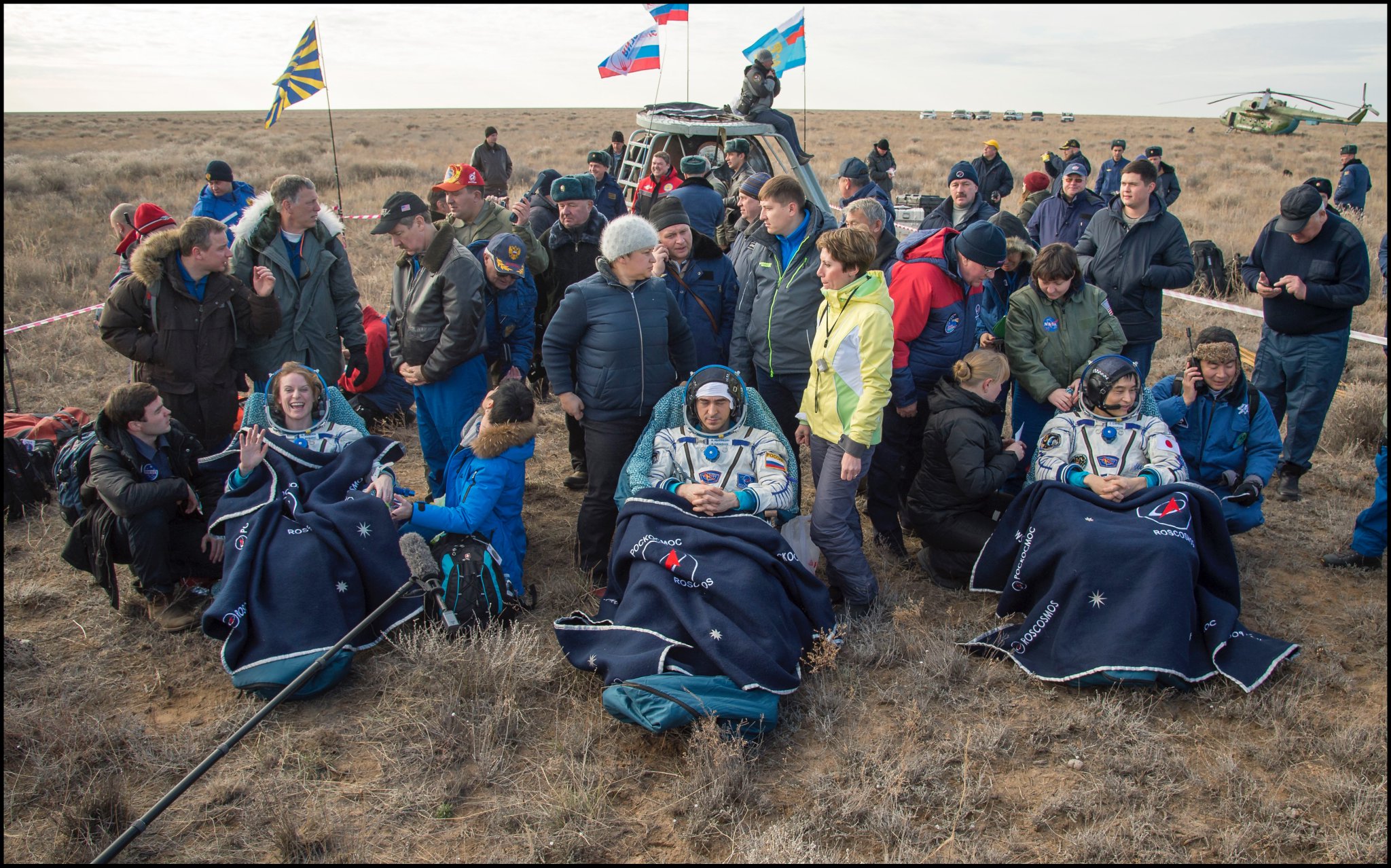
Only days before the 16th anniversary of the dawn of continuous habitation of the International Space Station (ISS), the 50th long-duration crew has officially taken command of the orbiting outpost. On Friday, outgoing Expedition 49 Commander Anatoli Ivanishin of Russia handed control to Expedition 50 Commander Shane Kimbrough, who will lead the multi-national outpost through late February 2017. This allowed Ivanishin and his crewmates—NASA’s Kate Rubins and Japan Aerospace Exploration Agency (JAXA) astronaut Takuya Onishi—to complete the packing of their Soyuz MS-01 spacecraft, prior to undocking and return to Earth on Saturday evening. With the safe return of Ivanishin’s crew, the ISS moves toward a 2017 which will likely see a reduced crew aboard the station, chiefly caused by ongoing delays to a new Russian research module.
As outlined previously by AmericaSpace, the changeover period between the two crews has been far shorter than intended, due to the month-long delay of Kimbrough and Russian cosmonauts Sergei Ryzhikov and Andrei Borisenko aboard Soyuz MS-02. Following the arrival of Kimbrough and his men on 21 October, the joint crew completed one last major objective, with the successful capture and berthing of Orbital ATK’s OA-5 Cygnus cargo ship on 23 October. Finally, on the 28th, the six astronauts and cosmonauts gathered in the station’s Destiny lab to offer their farewells and thanks.
“I have a feeling that we came to the space station just yesterday,” Ivanishin began, “and tomorrow it’s time for us to undock and go back to our planet.” He expressed thanks to the Expedition 48 crew, who had supported himself, Rubins, and Onishi during the first half of their four-month increment, and noted that none of his own crew’s success would have been possible without the aid of Mission Control Centers across the world. Perhaps offering an ironic nod to present conflicts on Earth, Ivanishin was philosophical. “I’m kind of reluctant to close the hatch, because being on space station is a very unique experience,” he said. “First of all, I didn’t have time to know what was going on, on our planet, and second, maybe it is for the better!” His quip was met with a grin from Kimbrough.
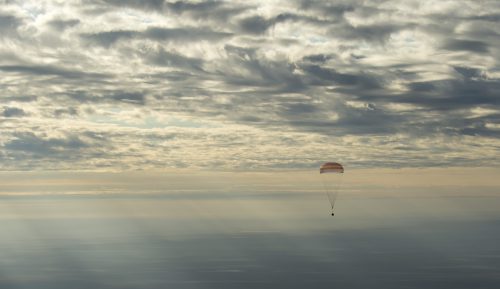
Ivanishin concluded that he would miss the “unique environment” of the ISS, where different cultures were mixed, and different languages were spoken, and yet all of whose members worked together as a unified crew for a unified goal. He then handed over the microphone to the new skipper of Expedition 50. “It’s really an honor and a privilege to take command of the International Space Station,” said Kimbrough, whose crew were clad in mauve shirts for the event, contrasting with the black shirts worn by Ivanishin, Rubins, and Onishi. He praised the outgoing crew for their record-setting achievement in terms of research, EVA, and robotics and the arrival and departure of several government and commercial visiting vehicles. “We’re sorry we’re only here a week with you,” he lamented. “You guys have trained us well. We’re ready to take charge of the space station … and we will sure miss you guys.”
Following final farewells on Saturday, hatch closure between Soyuz MS-01 and the station’s Earth-facing (or “nadir”) Rassvet module occurred at 5:12 p.m. EDT, about three minutes ahead of schedule. Andrei Borisenko oversaw the closure of the hatch from the ISS side. Ivanishin assumed the commander’s seat, in the center couch aboard the Soyuz, flanked by Onishi on his left side in the Flight Engineer-1 position and Rubins to his right as Flight Engineer-2. Over the next three hours, the trio donned their Sokol (“Falcon”) launch and entry suits and about 90 seconds before undocking Ivanishin commanded “open” the hooks linking Soyuz MS-01 to Rassvet. This enabled springs to push the two vehicles apart and undocking—and the official start of Expedition 50—occurred at 8:35 p.m. EDT.
A couple of minutes after physical separation, Ivanishin fired Soyuz MS-01’s thrusters for eight seconds to slightly increase the spacecraft’s departure rate. He then conducted a manual test of Soyuz MS-01’s new Reaction Control System (RCS), ahead of a 21-second thruster “burn” to further increase the distance between the spacecraft and the ISS. At 11:06:36 p.m. EDT Saturday—or 9:06:36 a.m. local time Sunday in Kazakhstan—Ivanishin executed the irreversible “deorbit burn,” committing Soyuz MS-01 to its perilous and fiery descent back through Earth’s atmosphere. The burn ran for four minutes and 37 seconds, slowing the spacecraft by about 420 feet (128 meters) per second and targeting a southeast-to-northwest ground track, heading across Kazakhstan to a landing site on the remote steppe.
Interestingly, tonight’s undocking not only saw astronaut Nicole Mann, from NASA’s 2013 astronaut intake, in the Capcom’s seat at the Mission Control Center (MCC) at the Johnson Space Center (JSC) in Houston, Texas, but also saw former astronaut Timothy “T.J.” Creamer as Flight Director. Creamer (dubbed “Sabre Flight”) became the first flown astronaut to complete Flight Director training and graduated in August 2016.
After the completion of the deorbit burn, Ivanishin’s crew was instructed to close their visors. Twenty-seven minutes after the burn, at 11:33 p.m., the spherical orbital module and cylindrical instrument module of the Soyuz were jettisoned, as planned, leaving only the beehive-shaped descent module to endure the intense heat of re-entry. By this point, Soyuz MS-01’s altitude had reached 86.6 miles (139.8 km), with just 25 minutes remaining until touchdown. Ten prime Mi-8 “Hip” twin-turbine helicopters, together with other Search and Rescue (SAR) aircraft, were confirmed as airborne, as a fleet of all-terrain ground vehicles converged on the targeted landing site.
“Entry Interface” occurred at 11:36 p.m., at an altitude of 327,756 feet, or approximately 62.2 miles (100 km), with peak heating loads reaching 1,370 degrees Celsius (2,500 degrees Fahrenheit) and maximum G-loads on the crew of around 4-5 G. At the landing site, the Mi-8s began to fly an oval-shaped “racetrack” pattern, as they awaited the arrival of Soyuz MS-01. After passing through the worst of re-entry heating, the spacecraft emerged from the plasma at 109,580 feet, or 20.7 miles (33.4 km). Shortly afterwards, in a multi-step fashion, its twin pilot parachutes were automatically deployed, followed by the 258-square-foot (24-square-meter) drogue and, lastly, the 10,764-square-foot (1,000-square-meter) main canopy. At the landing site, about 87 miles (140 km) northwest of the remote town of Dzhezkazgan, the Sun had risen on a clear morning, with local temperatures of just 1.1 degrees Celsius (34 degrees Fahrenheit), winds of 8.5 mph (13 km/h) from the southwest, and a broken cloud-deck at 4,000 feet (1,200 meters).
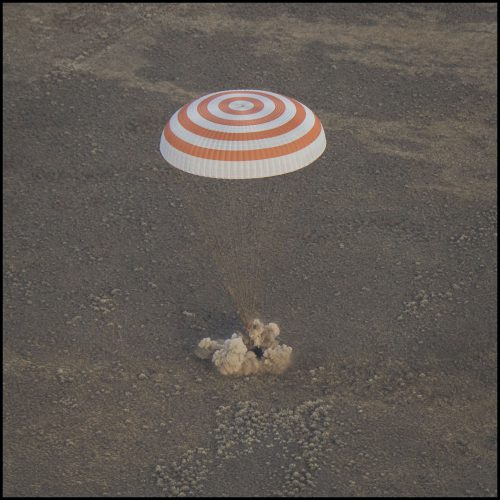
Images from the SAR helicopters and ground vehicles confirmed the satisfactory completion of the parachute deployment process, together with the separation of Soyuz MS-01’s base heat shield, which exposed the six solid-fueled landing thrusters and radar altimeter. The appearance of the huge orange-and-white main canopy slowed Ivanishin, Rubins, and Onishi to 23.6 feet (7.2 meters) per second and its harnesses initially oriented Soyuz MS-01 at a 30-degree angle to expel heat, and then a straight-vertical profile for the final descent to touchdown. Although slowed significantly, this was still not enough for a safe landing. Two seconds—and 2.6 feet (0.8 meters)—before impact, the solid-fueled thrusters briefly flared to reduce the descent rate to just 5 feet (1.5 meters) per second.
Soyuz MS-01 landed in an upright configuration at 11:58 p.m. EDT Saturday (9:58 a.m. local Kazakh time), wrapping up a space mission of 115 days, 2 hours, and 22 minutes for Ivanishin, Rubins, and Onishi. Although a handful of previous long-term station residents—European astronaut Leopold Eyharts and NASA flyers Garrett Reisman, Tim Kopra, and Nicole Stott—have clocked shorter individual increments, this represented the shortest-ever ISS expedition by a full crew.
Following customary checks in the medical tent, the three returned spacefarers were flown back to the city of Karaganda, capital of the Karaganda Region in which they landed, for a traditional Kazakh welcoming ceremony. Ivanishin will then fly back to the Gagarin Cosmonaut Training Center (GCTC) at Star City, on the forested outskirts of Moscow, whilst Rubins and Onishi board a NASA jet for the approximately 24-hour journey back to Ellington Field, near Houston.
With Expedition 50 now underway, the next few weeks should see Kimbrough’s crew expanded to six members. Soyuz MS-03 is scheduled to launch from Site 1/5 at Baikonur Cosmodrome at 2:20 a.m. local time on 18 November (3:20 p.m. EDT on 17 November), carrying Russian cosmonaut Oleg Novitsky, France’s Thomas Pesquet, and former NASA Chief Astronaut Peggy Whitson. Original plans called for Soyuz MS-03 to revert to a now-standard six-hour and four-orbit rendezvous profile, following the adoption of longer two-day and 34-orbit profiles adopted by the Soyuz MS-01 and MS-02 crews for spacecraft systems tests. However, on Friday Roscosmos and NASA revealed that Soyuz MS-03 will also follow a two-day rendezvous, due to phasing and orbital mechanics, with docking at the station’s Rassvet module anticipated at 5:05 p.m. EDT on 19 November.
Expedition 50 will maintain itself at six-crew strength until the return home of Kimbrough, Ryzhikov, and Borisenko on 25 February 2017, wrapping up an increment of 129 days. Whitson will then take command of Expedition 51, through her own crew’s landing in mid-May, and it is during this period that ISS crewing will decline. As noted previously by AmericaSpace, it is understood that long-running delays to the launch of the Nauka (“Science”) research module have triggered a decision to operate the Russian Orbital Segment (ROS) with just two cosmonauts in 2017, as opposed to the normal three. Although unconfirmed officially until recently, this was expected to see at least two “rookie” cosmonauts deleted from the crew rosters on a pair of upcoming missions.
Roscosmos announced Friday how the crewing manifest would pan out. Originally, Whitson’s Expedition 51 would have been rounded out in mid-March 2017 by the Soyuz MS-04 crew of Russian cosmonauts Aleksandr Misurkin and Nikolai Tikhonov, together with NASA astronaut Mark Vande Hei. The latter would then rotate into the core of Expedition 52 and be joined in late May by the Soyuz MS-05 crew of Russian cosmonaut Fyodor Yurchikhin, NASA’s Jack Fischer, and Italian astronaut Paolo Nespoli. Upon the return to Earth of Misurkin’s increment in late August 2017, Yurchikhin would take command of Expedition 53 and be subsequently joined by the Soyuz MS-06 crew of Russian cosmonauts Aleksandr Skvortsov and Ivan Wagner, plus NASA flyer Scott Tingle. The latter would rotate into Expedition 54 and be joined in the fall of 2017 by Soyuz MS-07’s Sergei Ryazansky of Russia, Randy “Komrade” Bresnik of NASA, and Norishige Kanai of Japan.
The decision to reduce ROS crewing earlier this year apparently led to the deletion of Tikhonov from Soyuz MS-04 and Wagner from Soyuz MS-06, effectively producing a pair of two-man crews. This necessitates additional preparation for Vande Hei and Tingle to assume Flight Engineer-1 duties aboard the Soyuz, which requires a more in-depth knowledge of spacecraft systems. Correspondingly, the Misurkin/Vande Hei and Skvortsov/Tingle crews have moved to the right and will now launch aboard Soyuz MS-06 in August 2017 and Soyuz MS-07 in October 2017.
However, with Jack Fischer having already trained as Flight Engineer-1 on Soyuz MS-05, he is more suitably positioned to rotate with Yurchikhin into a two-man crew. As a result, Yurchikhin and Fischer will now launch aboard Soyuz MS-04 in March 2017 to form the second half of Expedition 51, under Peggy Whitson’s command, and later rotate into the Expedition 52 core. Then, in late May, Ryazansky and Bresnik will launch aboard Soyuz MS-05, together with Nespoli, to complete Expedition 52. This will allow the Misurkin/Vande Hei crew to fly Soyuz MS-06 in August and the Skvortsov/Tingle, newly teamed with Norishige, aboard Soyuz MS-07 in October. This produces the interesting scenario of what may occur in August 2017. If a “direct rotation” of crew members occurs, there exists a possibility that Tikhonov or Wagner may join Misurkin/Vande Hei for the ride uphill and land a few days later with the returning Yurchikhin/Fischer crew.
Want to keep up-to-date with all things space? Be sure to “Like” AmericaSpace on Facebook and follow us on Twitter: @AmericaSpace




